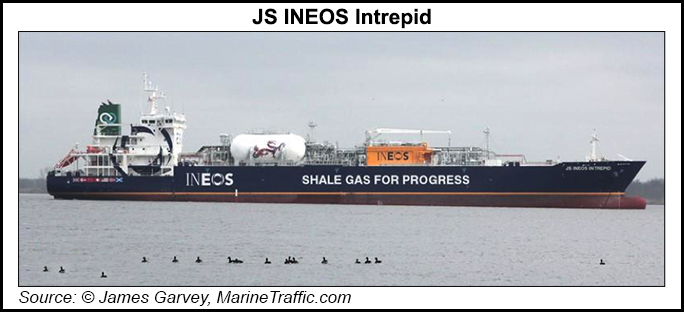Marcellus | E&P | NGI All News Access | NGI The Weekly Gas Market Report | Utica Shale
Europe Prepares to Receive First-Ever Shipment of U.S. Shale Gas From Appalachia
Marking another milestone this year for the U.S. shale industry, the first shipment of ethane gas produced in the Appalachian Basin set sail on Wednesday from Sunoco Logistics Partners LP’s Marcus Hook Industrial Complex for a 3,800-mile journey to Norway.

The shipment marks the first time that U.S. shale gas has been exported to Europe. The JS INEOS Intrepid left the complex near Philadelphia on a clear, warm day loaded with nearly 173,000 bbl of ethane bound for INEOS Group Ltd.’s Rafnes ethane cracker. The 591-foot ship left the terminal with a message, “Shale Gas For Progress,” pasted along its side in large white block letters.
The journey is expected to take nine to 10 days and according to MarineTraffic.com, as of Thursday, the ship was on course with an average speed of 10.2 knots.
Saying that it was the end of a “hugely ambitious project that has taken us five years” to complete, INEOS Chairman and Founder Jim Ratcliffe added that “this is an important day for INEOS and Europe. We know that shale gas economics revitalized U.S. manufacturing and for the first time Europe can access this important energy and raw material source, too.”
INEOS, with ethane crackers in Scotland and Norway, became the first European company to contract for U.S. feedstock in 2012, when it agreed to transport Range Resources Corp. production received through Sunoco’s Mariner East (ME) 1 pipeline (see Shale Daily, Sept. 28, 2012). Range is the anchor shipper on that system with 20,000 b/d of propane capacity and 20,000 b/d of ethane capacity. Range spokesman Matt Pitzarella confirmed Thursday that the ethane was produced by Range in the Marcellus Shale of Southwest Pennsylvania.
When it signed on as ME 1’s anchor shipper, Range said it expected propane deliveries to Marcus Hook to begin in the second half of 2014 and ethane deliveries to start in the first half of 2015. Wednesday’s exports came after minor delays on the system, which commissioned propane in late 2014 and only just started to ship ethane at the beginning of February. The company said on its year-end earnings call that the European exports would begin earning it higher netbacks for its liquids this year (see Shale Daily, Feb. 26a).
Sunoco spokesman Jeff Shields said he wasn’t entirely sure when the next exports are scheduled to leave Marcus Hook, but added that they are going to “become continuous” from this point forward. INEOS also has a contract for ethane that it signed with Consol Energy Inc. in 2014 (see Shale Daily, Feb. 14, 2014).
“Exporting natural gas to U.S. allies abroad from Pennsylvania marks a historic achievement, boosting America’s energy security while directly benefitting consumers and our environment,” said Marcellus Shale Coalition President David Spigelmyer. “This first ethane shipment — one of many more to come — reflects the fact that shale development continues to revitalize the greater Philadelphia region and the commonwealth.”
This week’s ethane exports come on the heels of the first cargo of liquefied natural gas (LNG) from Cheniere Energy Inc.’s Sabine Pass terminal. About 3 Bcf of U.S. LNG set sail from the terminal on the Gulf Coast headed for Brazil last month (see Daily GPI, Feb. 24).
Designated as “Dragon” class by the ships’ designer, Evergas, which specializes in petrochemical and liquid transportation, the ethane carriers are among the largest of their kind in the world. The 87-foot wide INEOS Intrepid is one of four specially designed ships that will form part of an eight-ship fleet chartered by the company (see Shale Daily, June 17, 2015).
INEOS expanded its Rafnes site in Norway and its Grangemouth cracker site in Scotland to provide more ethane storage to feed those plants. The Norway site was also upgraded to handle receipt of the ships. Exports are expected to grow, too. Sunoco is still developing its ME 2 pipeline, which would transport ethane, butane and propane from processing and fractionation complexes in Eastern Ohio, Western Pennsylvania and West Virginia to Marcus Hook.
The pipeline’s start-up has been delayed until next year to secure necessary permits (see Shale Daily, Feb. 26). Sunoco is also still conducting an open season for a third pipeline, Mariner East 2X. All three pipelines, combined with Mariner West, which moves Marcellus ethane to Michigan and the Canadian border, would have a capacity of up to 800,000 b/d.
Marcus Hook, a former oil refinery, is being repurposed for natural gas liquids (NGL) storage, processing and distribution to domestic and international markets.
“The opening of the Mariner East pipeline represents a vital first step in redirecting Pennsylvania’s abundant NGLs to critical markets here at home,” said Pennsylvania Gov. Tom Wolf about the first phase of the ME project and the local benefits it would provide, too. “Sunoco Logistics is making a $3 billion investment in Pennsylvania’s energy economy by keeping Marcellus Shale resources for manufacturing right here in Pennsylvania, rather than sending this business, revenue and jobs to other states.”
© 2024 Natural Gas Intelligence. All rights reserved.
ISSN © 2577-9877 | ISSN © 1532-1266 | ISSN © 2158-8023 |
